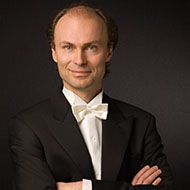At a Glance
STRAVINSKY
A man of the theater, Igor Stravinsky composed some of the most memorable dance scores of the twentieth century, charging out of the gate in 1910 with The Firebird. His contributions to the stage would later expand to include operas and spoken/sung works with orchestra, such as Perséphone.
Perséphone 1934 | 48 mins
Ida Rubinstein was a tall woman of what has been described as “mysteriously androgynous beauty.” She kept a black tiger cub, and it was rumored that she drank champagne out of Madonna lilies. Her real talent was in mime, but she was ambitious to dance, act, and sing. In January 1933 she asked André Gide to approach Stravinsky about a collaboration for a “symphonic ballet” based on Gide's Hymn to Demeter. The resulting Perséphone is one of Stravinsky’s illuminating paeans to spring all lyric leisure and grace, yet each note is still striking and fierce. The composer hinted at what we might especially LISTEN FOR: “I love the music, especially the flutes in Perséphone’s final speech . . . and the final chorus. . . . I love the chord before the Russian Easter music, too [when the chorus sings “Nous apportons nos offrandes,” or “We bring our offerings”], and I love, above all, the lullaby Sur ce lit elle repose [On this bed she rests.]”
The Firebird 1910 | 45 mins
The first performance of The Firebird by Serge Diaghilev’s Ballets Russes made Stravinsky a celebrity—for life. Its Parisian audience wanted a taste of the avant-garde, and with this ballet score the twenty-seven-year-old more than delivered. The company made a specialty of dancing works inspired by Russian folklore, and The Firebird was perfectly suited to Ballets Russes designs. The fantastical tale involves a dashing prince, an evil sorcerer, enchanted princesses, a magic egg, and, of course, the mythical and mystical titular creature. LISTEN FOR: Scored for an orchestra of luxurious size and richness, Stravinsky’s colorful score takes advantage of each instrument’s specific sound to enliven individual characters. ”
STEVEN ZIEGLER is Managing Editor of Publications at the San Francisco Symphony


